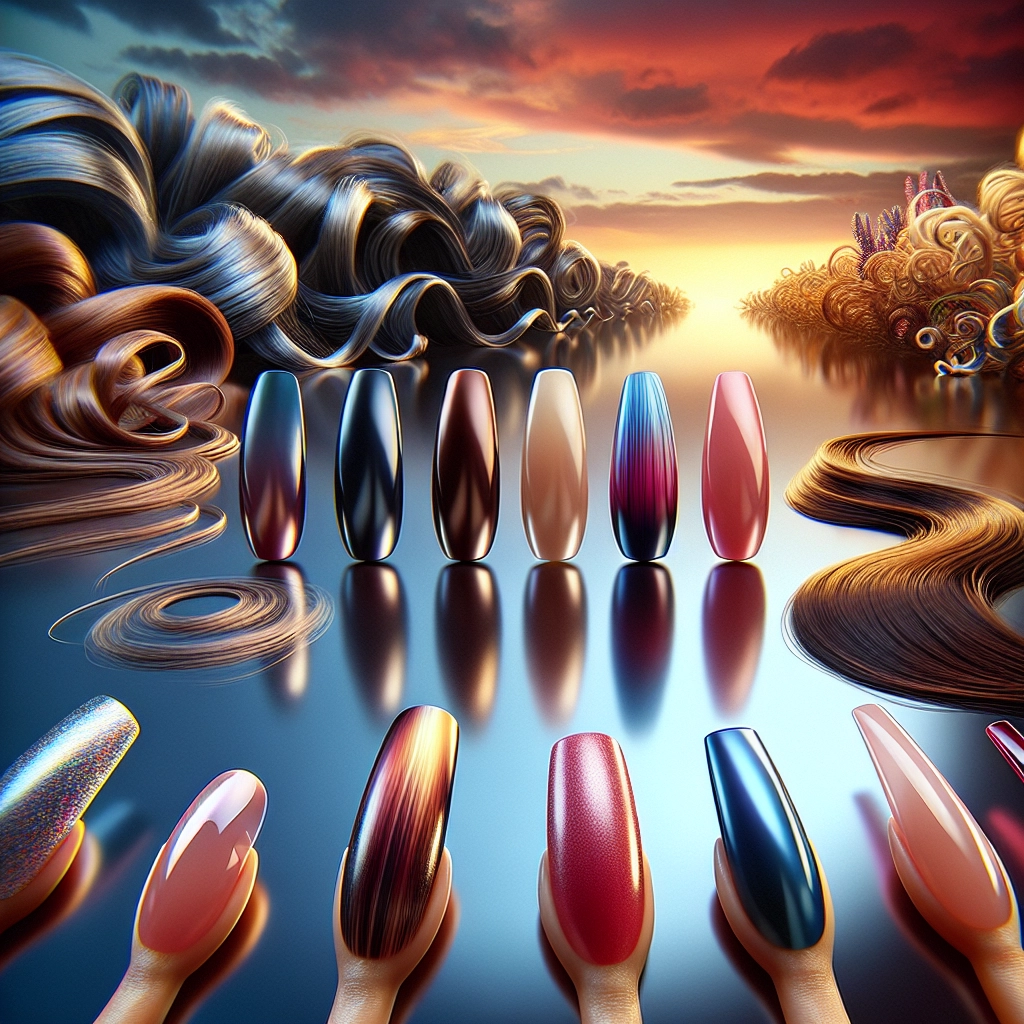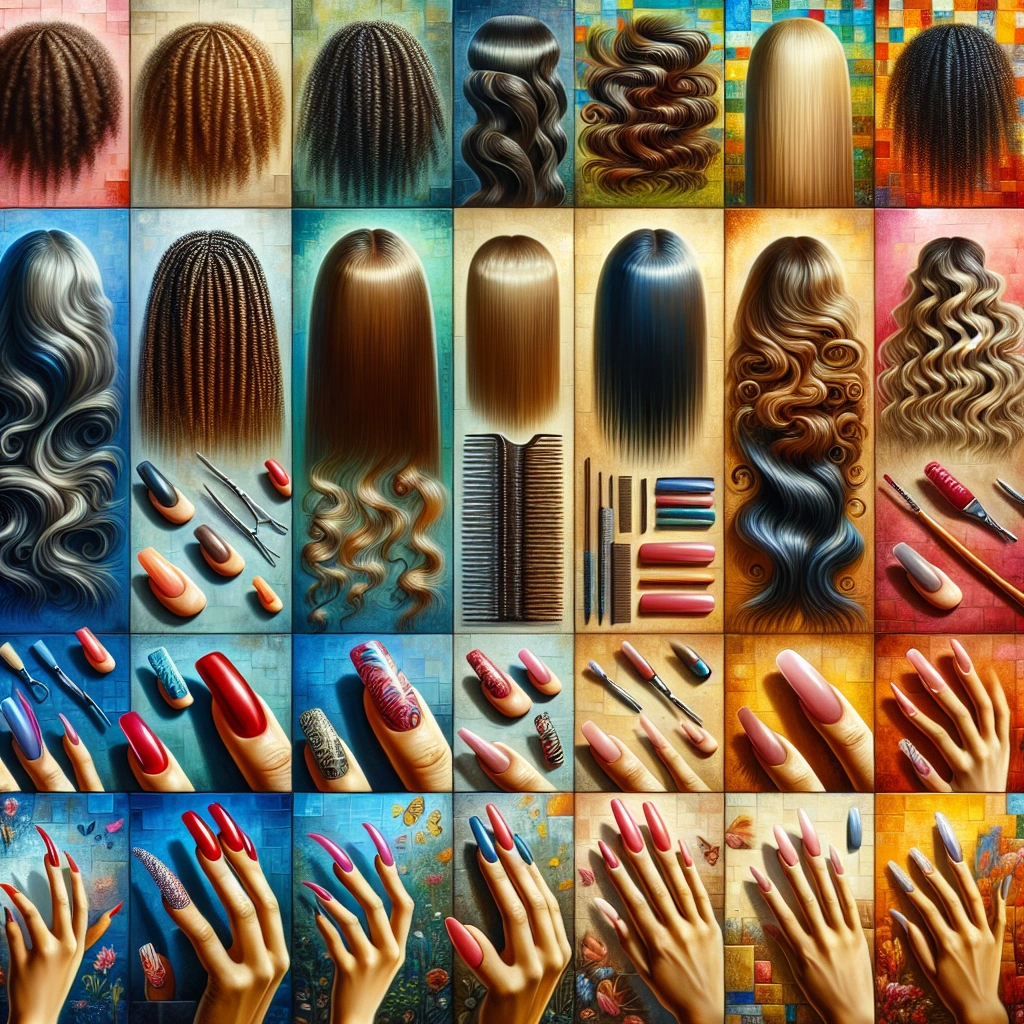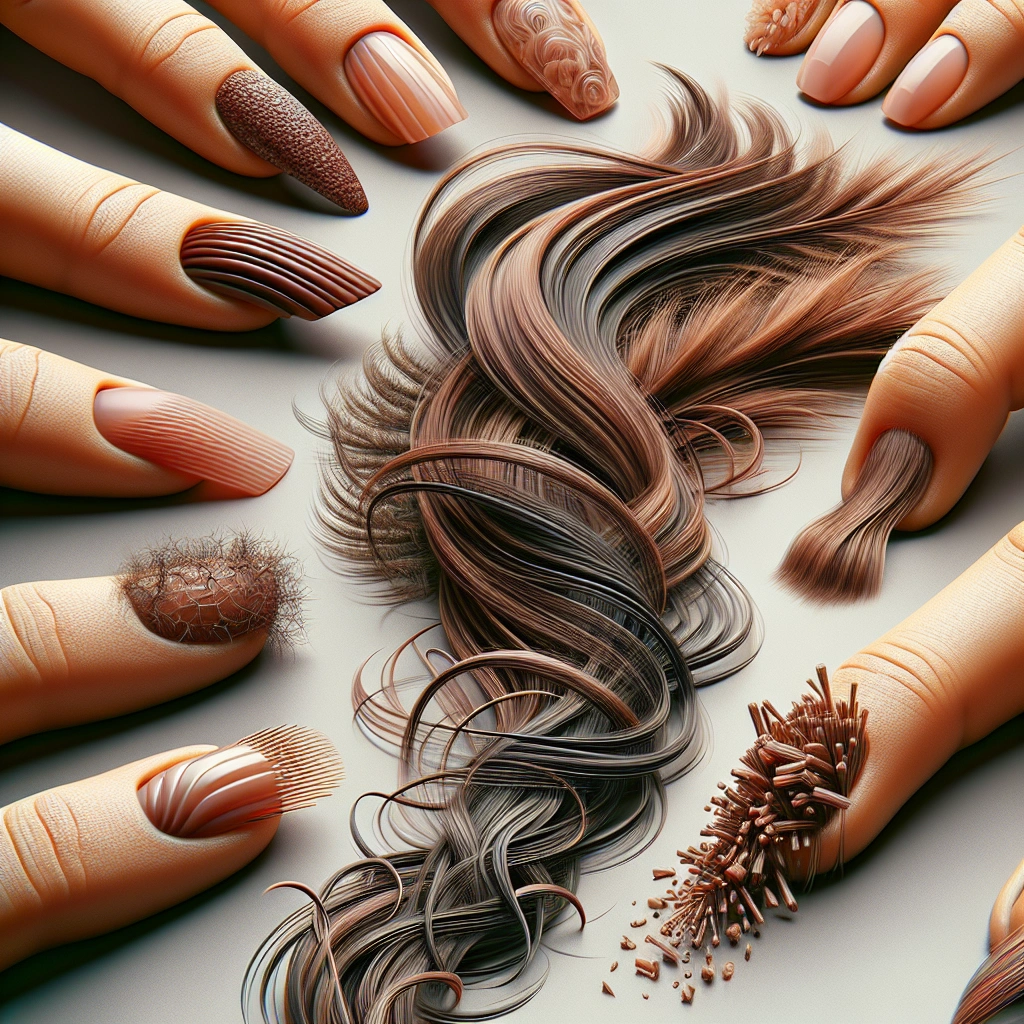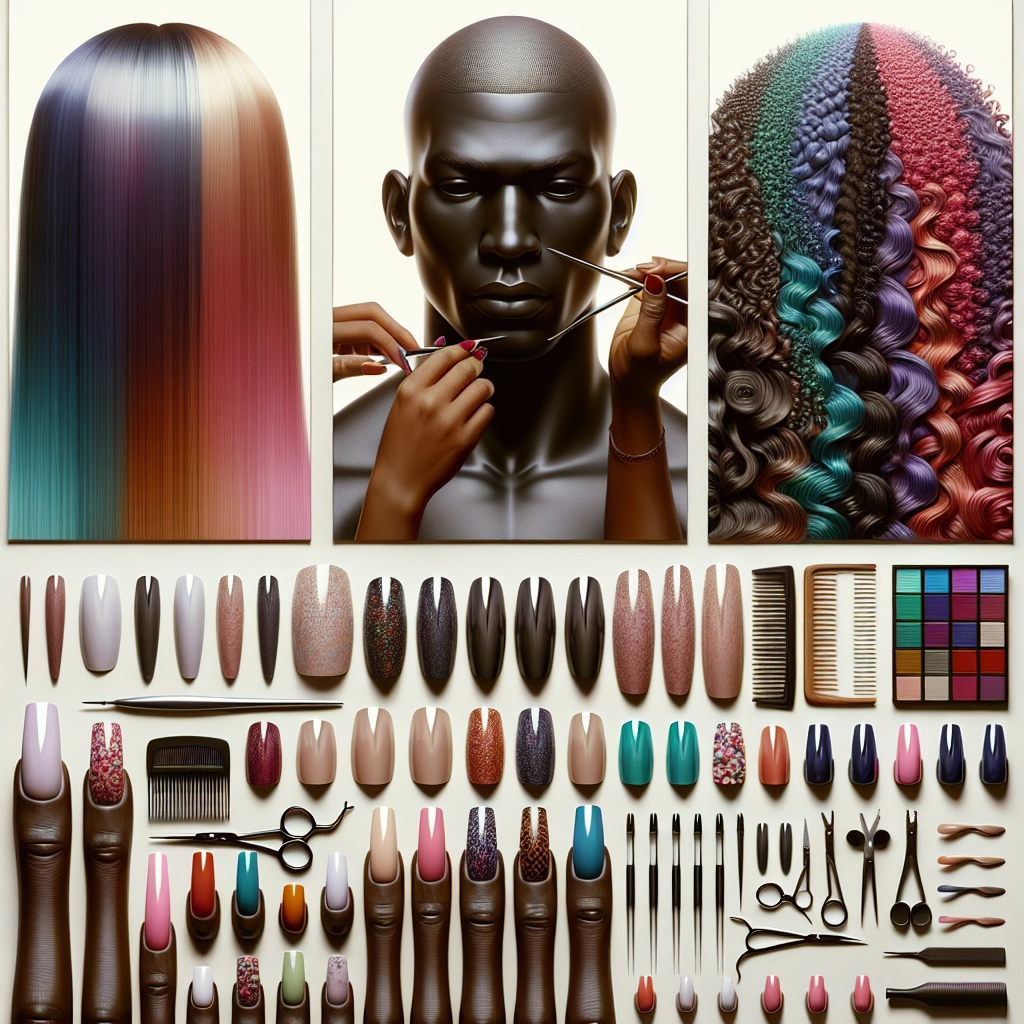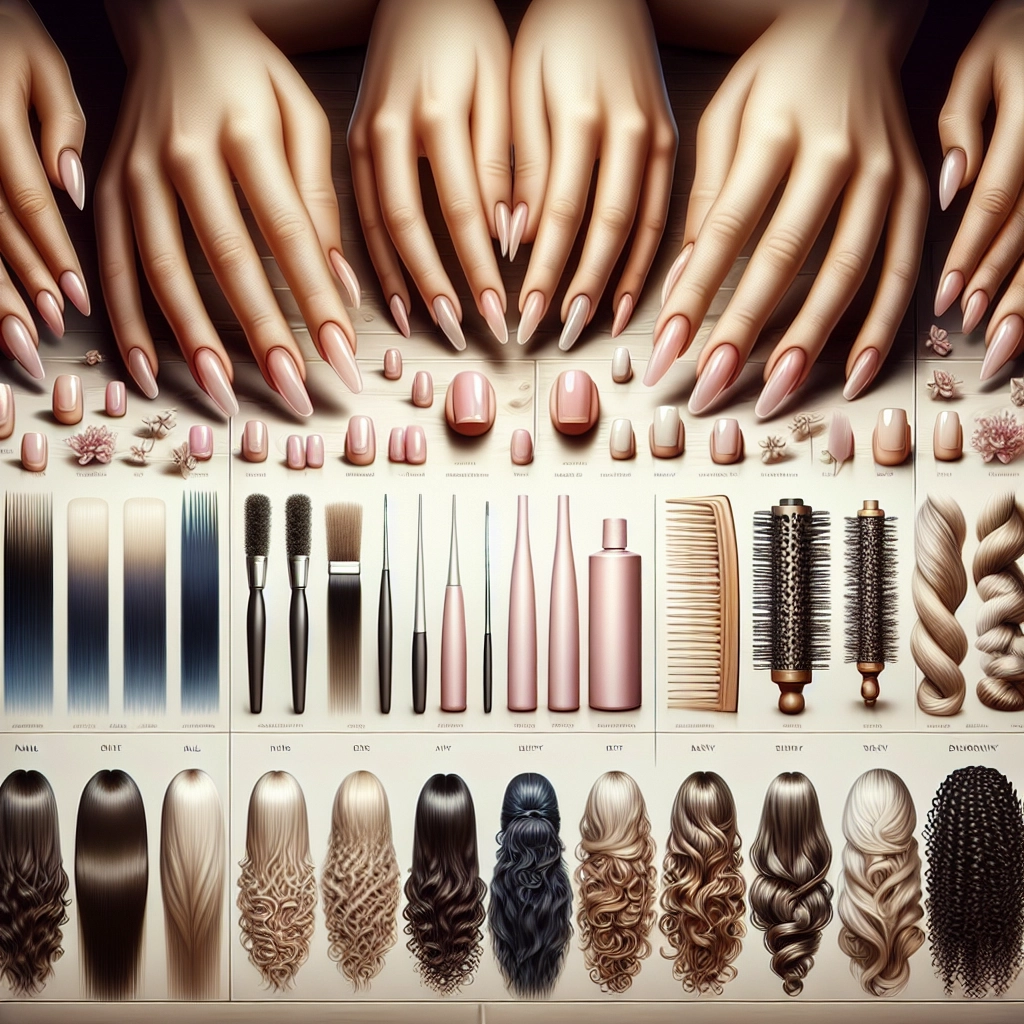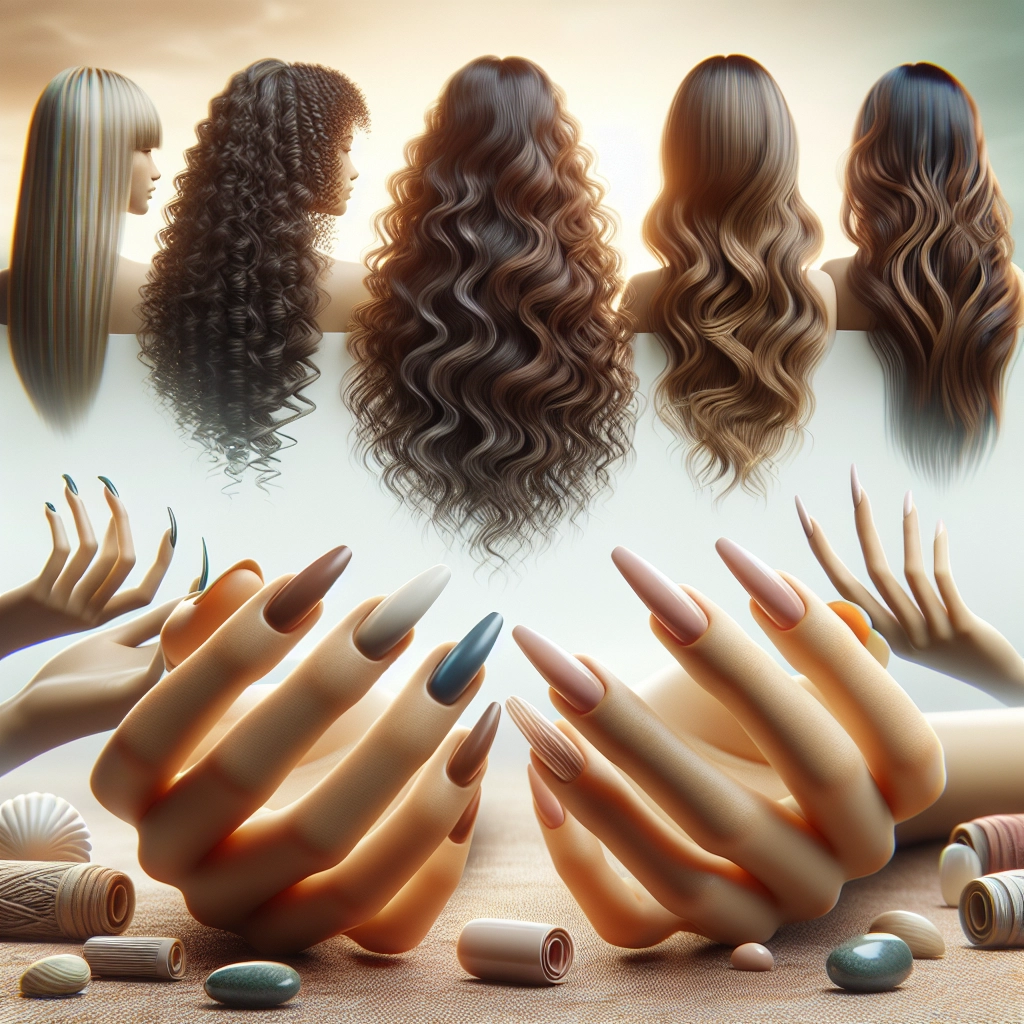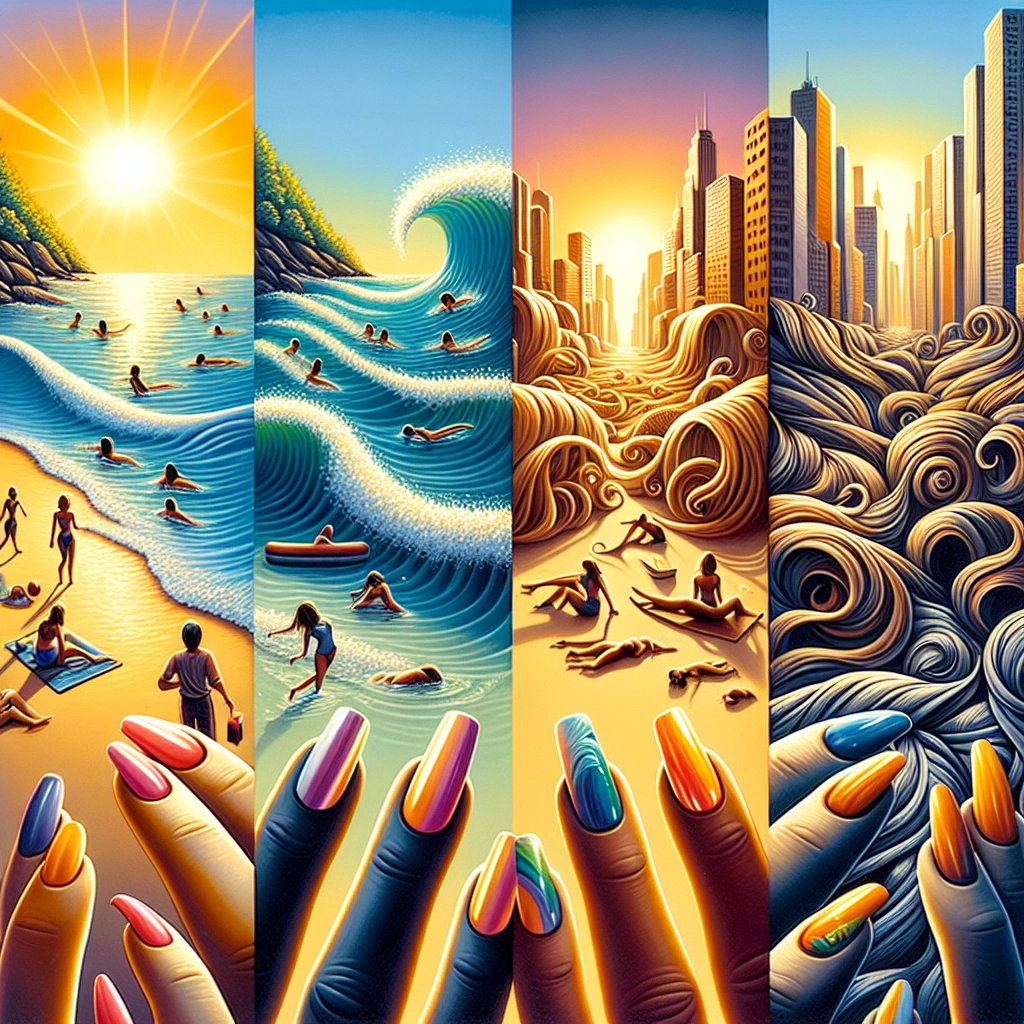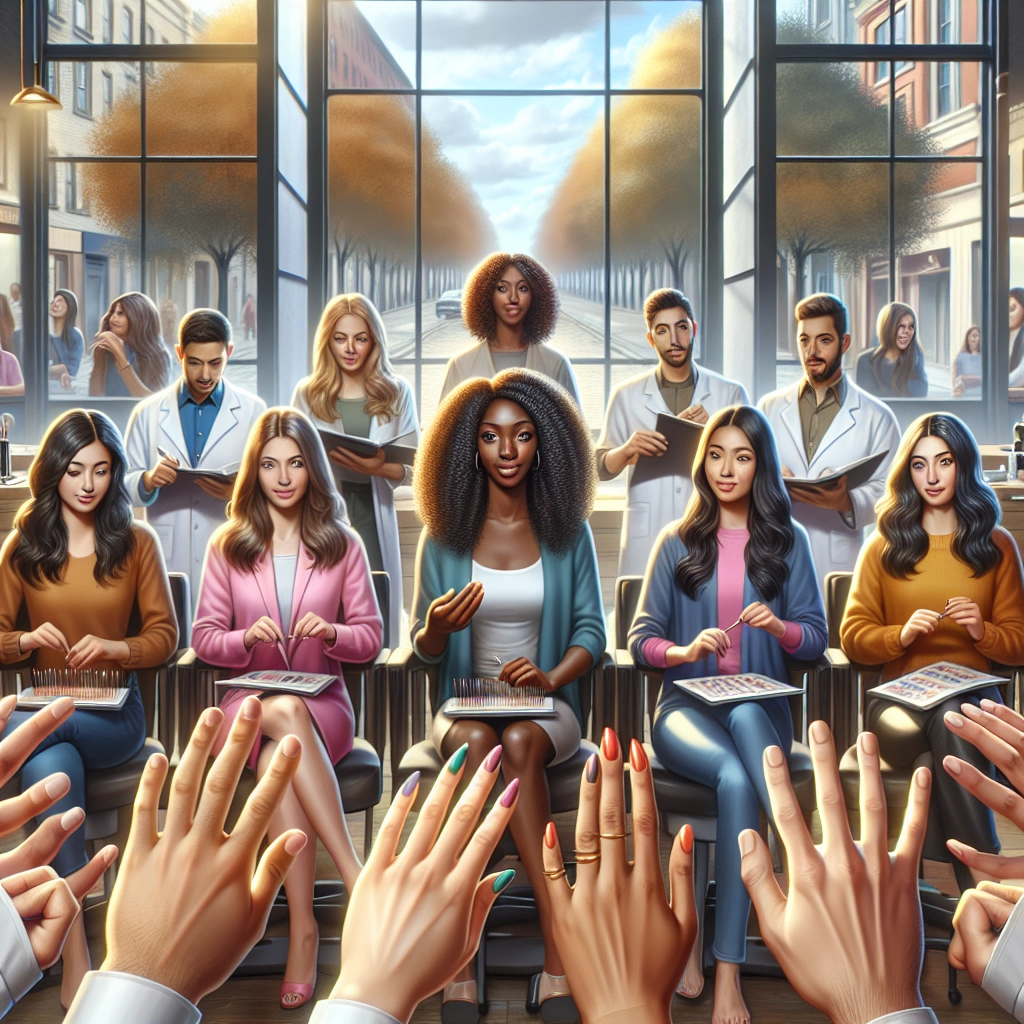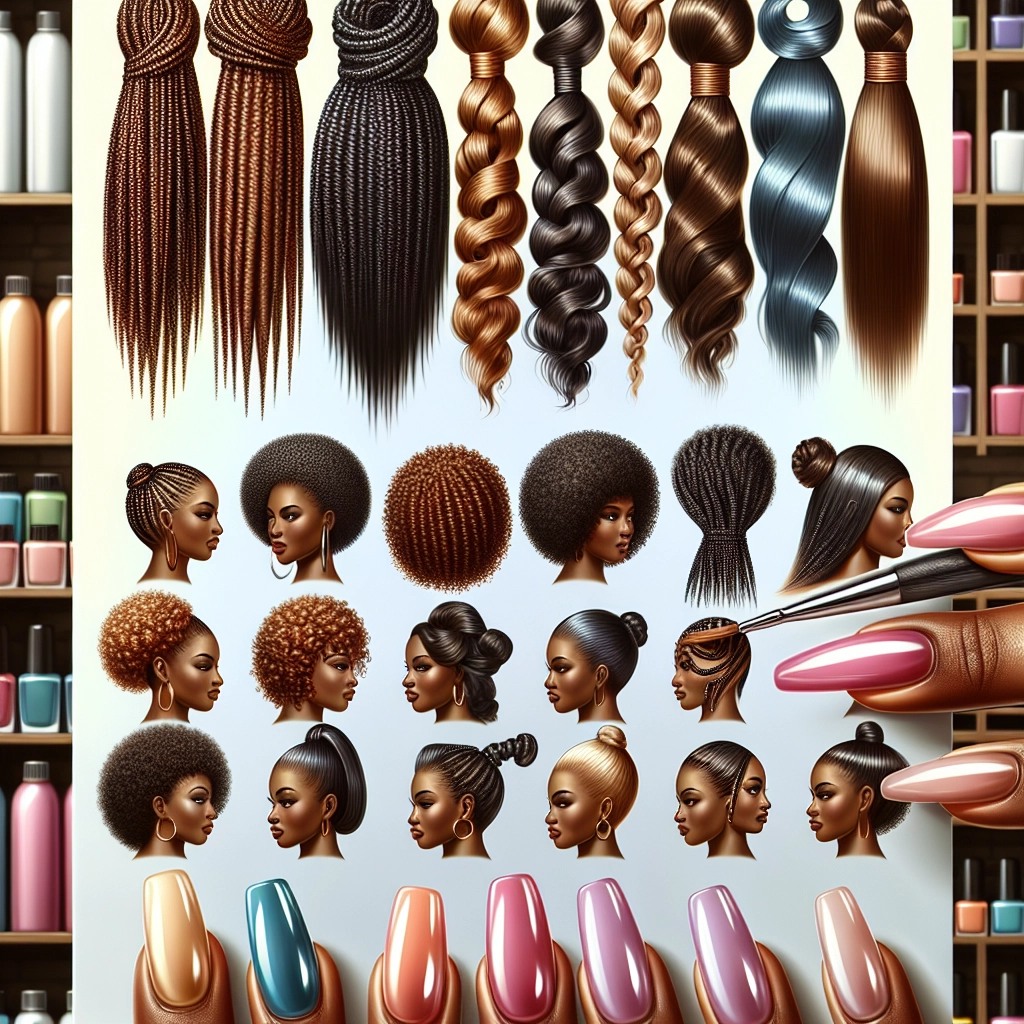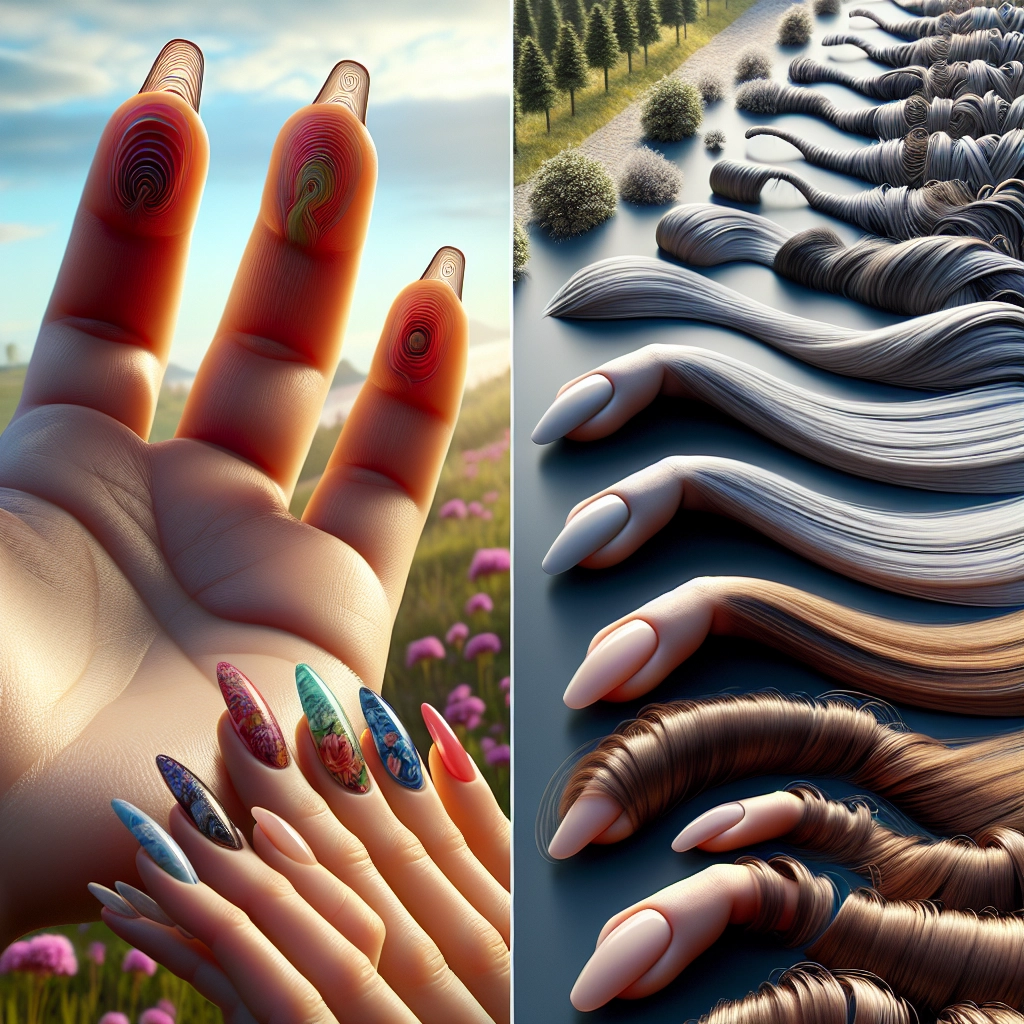

Understanding different hair textures and types of nails is crucial for proper hair care and nail maintenance. Different hair textures require different care and styling techniques, and knowing the specific type of nails can help in choosing the right manicure.
It is important to be knowledgeable about these aspects to ensure that the appropriate products and treatments are used for optimal results.
Hair textures are generally categorized into fine, medium, and thick, with additional subcategories such as straight, wavy, curly, and coiled. Each hair type requires specific hair care routines and styling methods.
On the other hand, there are various types of manicures such as classic, French, gel, acrylic, and more, each catering to different nail shapes and preferences.
By understanding the different hair textures and types of nails, individuals can make informed decisions about hair care and nail treatments. This knowledge allows for proper care and maintenance, leading to healthier and more beautiful hair and nails.
Different hair types and nail shapes require specific products and techniques, highlighting the importance of understanding and recognizing these variations.
Check out this Youtube video: “Hair On Set Part 2: Hair Texture – YouTube” to learn about the different hair textures and types of nails for a deeper understanding of haircare and beauty.
Different Hair Textures
| Hair Texture | Characteristics |
|---|---|
| Fine Hair | Naturally soft and silky, lightweight strands that are easily straightened. May lack volume and be prone to tangling. |
| Medium Hair | Thicker than fine hair, with two layers and possibly a medulla. Feels moderate in terms of texture and feels silky when healthy and straight. |
| Coarse Hair | Thickest strands, containing all three layers of the hair shaft – cortex, cuticle, and medulla. Can appear strong and luscious with the right care. |
Different Types of Nails
Dry, brittle nails
Dry, brittle nails are characterized by excessive dryness, brittleness, and a tendency to break, split, or peel easily. This condition can result from factors like aging, frequent exposure to water or harsh chemicals, and certain medical conditions.
Using moisturizing hand lotions with ingredients like lanolin or alpha-hydroxy acids can help restore moisture and flexibility to the nails. Additionally, wearing gloves when handling water and using gentle nail care practices can prevent further damage.
Soft, weak nails
Soft, weak nails are prone to bending and breaking, often due to insufficient nutrients or underlying health issues like thyroid disease or anemia. Exposure to harsh chemicals in cleaning products can also cause nails to become soft and bendy.
Ensuring a balanced diet rich in essential vitamins and minerals, and minimizing exposure to harsh chemicals, can contribute to strengthening and improving the texture of soft and weak nails. Seeking medical advice for underlying health conditions is crucial for addressing this nail type.
Normal nails
Normal nails exhibit a smooth texture, uniform color consistency, and are free of spots or discoloration. They are neither excessively dry and brittle nor soft and weak.
Healthy nail care practices, such as keeping the nails clean, trimmed, and moisturized, contribute to maintaining normal nail texture and appearance. Implementing a balanced lifestyle and diet, using proper nail care products, and avoiding harmful chemicals are key factors in maintaining the health and strength of normal nails.
Understanding Your Specific Hair Type
Importance of knowing your specific hair type
Knowing your specific hair type is crucial because it determines the most suitable care and styling methods. Understanding whether your hair is straight, wavy, curly, or coily helps in selecting the right products and treatments to maintain healthy and luscious locks. Ignoring your hair type can lead to ineffective hair care practices, resulting in frizz, breakage, and overall hair damage.
Tips for identifying your hair texture
To identify your hair texture, consider the shape and pattern of your strands. Straight hair is characterized by smooth and sleek strands, while wavy hair has a gentle ‘S’ pattern. Curly hair forms spiral or ringlet shapes, and coily hair showcases tight, spring-like coils. You can also determine your hair texture by comparing a strand of your hair to a piece of thread to ascertain if it’s fine, medium, or thick/coarse.
Hair care tips based on your hair texture
Tailoring your hair care routine to your specific hair texture is crucial for maintaining its health and appearance. For instance, individuals with straight hair benefit from lighter, volumizing products, while those with curly or coily hair require hydrating and defining products. Understanding your hair texture aids in selecting the right shampoo, conditioner, and styling products to keep your locks looking their best.
| Hair Type | Description | Recommended Products |
|---|---|---|
| Type 1: Straight | Smooth and sleek | Lightweight, volumizing shampoos and conditioners |
| Type 2: Wavy | ‘S’ pattern strands | Hydrating, frizz-control products for definition |
| Type 3: Curly | Spiral or ringlet shapes | Moisturizing, curl-enhancing products |
| Type 4: Coily | Tight, spring-like coils | Deep-conditioning treatments, curl-defining creams |
Remember, understanding your specific hair type is the first step towards achieving and maintaining healthy, beautiful hair. So, embrace your unique hair texture and care for it with the right products and techniques tailored to its specific needs.
Nail Care Based on Your Nail Type
Importance of understanding your nail type
Understanding your nail type is crucial for effective nail care. Just like different hair textures require specific care routines, different nail types demand personalized attention.
By identifying whether your nails are dry and brittle, soft and weak, or normal, you can tailor your care routine to address the specific needs of your nails. This knowledge allows you to use the right products and techniques to maintain healthy and beautiful nails.
Nail care tips for dry, brittle nails
For dry, brittle nails, it’s essential to focus on hydration and protection. Use a nourishing cuticle oil regularly to replenish moisture and improve nail flexibility.
Opt for nail polishes with added vitamin E or hydrating properties to prevent further drying. Avoid excessive exposure to water and harsh chemicals, and always wear gloves when engaging in activities that could damage your nails.
Incorporating a biotin supplement into your daily routine can also promote nail strength and growth.
Nail care tips for soft, weak nails
Soft, weak nails require gentle care and reinforcement. Consider using a strengthening base coat to provide a protective barrier and minimize breakage.
Keep your nails trimmed to prevent snagging and incorporate a calcium-rich nail hardener into your routine to fortify the nails. Limit prolonged exposure to water and chemical products, and always use gloves when handling household cleaning agents.
Maintaining a balanced diet rich in essential nutrients like protein, calcium, and vitamins can also contribute to stronger, healthier nails.
Nail care tips for normal nails
Proper maintenance is key to preserving the health of normal nails. Regularly moisturize your hands and nails with a nourishing lotion to keep them hydrated.
Consider applying a clear protective top coat to shield your nails from external damage. Keep your nails neatly trimmed and file them in one direction to prevent splitting.
Avoid using your nails as tools to prevent unnecessary stress and breakage. Lastly, maintain a well-balanced diet and stay hydrated to support overall nail health.
Common Hair and Nail Problems
Split ends and breakage
Split ends and breakage can be prevented by following a few simple tips. Be gentle after washing your hair to avoid unnecessary stress on the strands. Detangle your hair using a wide-tooth comb to minimize breakage. Hydrate your hair regularly with deep conditioning treatments to maintain its strength and elasticity. Limit the use of heat styling tools such as flat irons and curling wands to prevent split ends.
Fungal nail infections
Fungal nail infections are primarily caused by various fungal organisms, with the most common being dermatophyte. It’s essential to be cautious of the environments that may harbor these fungi, such as public showers or swimming pools. Additionally, proper foot hygiene and regular nail care can help reduce the risk of developing fungal nail infections.
Cuticle damage
Cuticle damage can be resolved by using an effective cuticle treatment. Regular moisturization of the hands and cuticles is crucial to maintaining their health and preventing dryness or peeling. Consider using products like Nailtopia Orange Cuticle Conditioner or CND Solar Oil Nail and Cuticle Conditioner to revive the health of your cuticles.
Creating a Hair and Nail Care Routine
Establishing a hair care routine
To establish a hair care routine, you must first identify your hair type, be it oily, dry, normal, or wavy. Once identified, use specific products tailored to your hair type for cleansing, conditioning, and nourishing. Additionally, detangle hair after showering and protect it with heat protection products before styling. Moisturizing is also crucial for maintaining healthy and vibrant hair.
Establishing a nail care routine
Establishing a nail care routine starts with trimming nails to ensure they are even in length. Follow by using a file to shape them and practicing good nail hygiene. This includes using sharp manicure scissors, trimming nails straight across, and rounding the tips gently. Regular nail trimming and cleanliness are essential for maintaining healthy nails.
Recommended products for different hair textures and nail types
| Hair Texture | Recommended Products |
|---|---|
| Fine Hair | Lightweight shampoos and conditioners, volumizing mousse |
| Medium Hair | Nourishing shampoos, rich conditioners, heat protection sprays |
| Thick Hair | Moisturizing shampoos, deep conditioning masks, leave-in treatments |
| Wavy Hair | Curl-enhancing shampoos, smoothing conditioners, anti-frizz serums, salt sprays |
| Nail Types | Recommended Products |
|---|---|
| Dry Nails | Hydrating cuticle oils, moisturizing hand creams |
| Brittle Nails | Nail strengtheners, protective base coats, vitamin-infused nail polishes |
| Weak Nails | Nail hardeners, strengthening treatments, calcium-rich nail supplements |
| Normal Nails | Moisturizing hand creams, strengthening top coats, regular nail maintenance |
Remember, consistency is key to seeing improvements in both hair and nail health. Embracing a tailored routine with the right products for your specific hair texture and nail type will lead to healthier, more resilient strands and nails.
Styling Tips for Different Hair Textures
Styling fine hair
To add volume to fine hair, opt for lightweight volumizing shampoos and conditioners as the foundation. Additionally, use lightweight mousses, root-lifting sprays, or volumizing sprays for a volume boost.
Consider hairstyles with layers and textures, like bixie haircuts or pixie cuts, to add movement and the illusion of fuller, thicker hair.
Styling medium hair
For men with medium length hair, consider using volumizing shampoos and conditioners, water-based pomade, texture paste or clay, and light creams for styling. These products can add texture and hold to medium hair, allowing for versatile and trendy styling options.
Styling coarse hair
Managing and styling coarse hair requires a healthy hair care routine with moisturizing products and avoiding parabens, sulphates, and other drying ingredients. Look for specific haircare products designed for coarse hair, such as leave-in treatments and smoothing foams, to maintain moisture and manageability.
| Hair Texture | Styling Tips |
|---|---|
| Fine Hair | Use lightweight volumizing shampoos and conditioners, mousses, and root-lifting sprays. Consider hairstyles with layers and textures. |
| Medium Hair | Use volumizing shampoos, water-based pomade, texture paste or clay, and light creams. These products add texture and hold to medium hair. |
| Coarse Hair | Follow a hair care routine with moisturizing products and avoid drying ingredients. Look for specific haircare products designed for coarse hair. |
These styling tips for different hair textures aim to enhance the natural qualities of each hair type while providing insights for achieving desired looks. By understanding the unique characteristics of fine, medium, and coarse hair, individuals can tailor their styling routines to best suit their specific needs and preferences.
Grooming Your Nails
Understanding the anatomy of the nail
The nail anatomy comprises the nail plate, nail bed, nail matrix, and supporting tissues. The nail plate is the hard, keratinized structure that emerges from the nail bed, while the nail bed is the skin beneath the nail plate, supplying nourishment to the nail.
The nail matrix, or germinal matrix, is the active tissue generating nail cells, and any disruptions can affect nail appearance and health.
Proper nail grooming techniques
Proper nail grooming involves cutting the nails straight across while they are softened, preferably after a bath or shower. Softening the nails before trimming is essential to prevent nail breakage and ensure a smooth cut.
It’s advisable to use the appropriate tools, including nail clippers, scissors, nippers, and a nail file, to achieve the desired nail shape and length.
Nail grooming tools and their uses
Nail grooming tools play a vital role in maintaining healthy and attractive nails. Essential tools such as nail clippers, scissors, nippers, and a nail file are crucial for cutting and shaping nails.
Additionally, a nail buffer can help smooth out ridges, while a cuticle pusher is essential for maintaining well-groomed cuticles and preventing hangnails.
| Grooming Tool | Use |
|---|---|
| Nail Clippers | For cutting nails straight across |
| Nail Scissors | For shaping and trimming nails |
| Nail Nippers | For precision trimming of cuticles and hangnails |
| Nail File | For achieving the desired nail shape and length |
| Nail Buffer | For smoothing out nail ridges |
| Cuticle Pusher | For maintaining well-groomed cuticles |
Grooming your nails with the right techniques and tools not only enhances their appearance but also contributes to overall nail health and well-being. By understanding the anatomy of the nail and incorporating proper grooming practices, you can achieve beautiful, well-maintained nails that complement your overall look.
Best Practices for Healthy Hair and Nails
Importance of a balanced diet
A balanced diet plays a pivotal role in maintaining healthy hair and nails. Incorporating foods rich in essential nutrients such as biotin, protein, and vitamins A, C, and E can significantly contribute to the strength and vitality of hair and nails.
For instance, consuming eggs, berries, and spinach can provide the necessary proteins and vitamins crucial for promoting hair growth and maintaining strong, healthy nails.
Hydration and its impact on hair and nails
Hydration is a key factor in the health of hair and nails. Adequate water intake ensures that the body functions optimally, promoting hair growth and nail health.
Though the general recommendation is to drink eight cups of water per day, individual requirements may vary based on body weight and activity level. Therefore, it’s important to stay mindful of personal hydration needs to support robust hair and nail health.
Regular trims and nail maintenance
Regular trims are essential for maintaining healthy hair, as they help prevent split ends and breakage. Similarly, adequate nail maintenance and care, such as biweekly manicures, can promote nail strength and minimize issues like peeling and chipping.
By incorporating regular trims and nail care into your self-care routine, you can contribute to the overall health and appearance of your hair and nails.
Environmental Factors Affecting Hair and Nails
Sun exposure
Sun exposure can wreak havoc on hair, leading to discoloration, dryness, split ends, and frizziness. The sun weakens the hair’s protein structure, de-moisturizes it, and reduces elasticity, making it more prone to breakage.
Protect your hair from the sun’s harmful rays by using UV-protective hair products and wearing hats or scarves when outdoors for prolonged periods.
Humidity and moisture levels
Humidity levels play a significant role in hair health. Dry air can make fingernails brittle and prone to breakage, while humid air can make them more flexible.
To combat these effects, consider using moisturizing products, avoiding excessive heat styling, and keeping your nails and hair well-nourished and moisturized.
Chemical exposure and its impact on hair and nails
Chemical exposure, especially from hair dyes and nail products, can pose health risks. Salon workers, in particular, are exposed to harmful chemicals, leading to potential respiratory, skin, or ingestion issues.
To minimize these risks, use high-quality, low-toxin nail products and ensure adequate ventilation in salon settings to protect both workers and clients.
| Factors | Impact on Hair and Nails |
|---|---|
| Sun Exposure | Discoloration, dryness, split ends, frizziness, weakened protein structure, de-moisturization |
| Humidity Levels | Brittle nails in dry air, flexible nails in humid air, impact on hair moisture and protein bonds |
| Chemical Exposure | Health risks, respiratory and skin issues, ingestion risks, especially for salon workers |
The Psychological Impact of Hair and Nail Health
Boosting self-confidence through good hair and nail care
Healthy, well-groomed hair and nails play a pivotal role in boosting self-confidence. When you have a great hair day or flawless nails, it’s natural to feel a surge in confidence and self-assurance.
Just like driving a clean, polished car makes you feel good, having healthy hair and nails elevates your self-esteem to another level.
How overall well-being affects hair and nail health
Your overall well-being directly influences the health of your hair and nails. Factors like stress, anxiety, and depression can lead to hair loss, brittle nails, and other issues.
A balanced diet, adequate sleep, and regular exercise contribute to healthier hair and nails as they improve blood circulation and provide essential nutrients to support their growth and strength.
Addressing insecurities related to hair and nail appearance
Insecurities tied to hair or nail appearance can significantly impact our self-image. It’s essential to address these insecurities by seeking professional advice, adhering to a healthy hair and nail care routine, and embracing your natural beauty.
Surround yourself with positivity and focus on self-care practices that uplift your confidence.
| Factors | Impact |
|---|---|
| Regular haircare | Boosts confidence |
| Balanced diet | Healthier hair and nails |
| Professional advice | Addresses insecurities |
| Self-care practices | Uplifts confidence |
Let’s embrace the power of confidence-boosting hair and nail care, recognizing the integral role they play in our overall well-being.
Seeking Professional Advice
When to consult a hairstylist or trichologist
If you notice sudden changes in your hair’s texture, thickness, or quality, it’s essential to consult a trichologist. These changes could be due to nutritional deficiencies, hormonal fluctuations, or even damage from styling practices.
Seeking professional advice early can help identify and address underlying issues before they escalate.
When to see a dermatologist for nail concerns
When you notice changes in the color, texture, or shape of your nails, it’s crucial to see a dermatologist. Nail concerns such as discoloration, pitting, or lifting could indicate underlying health issues.
Consulting a dermatologist for nail concerns ensures early detection and appropriate treatment, preventing potential complications.
Possible underlying health issues related to hair and nail problems
Hair and nail problems can be indicative of underlying health issues such as nutritional deficiencies, hormonal imbalances, or autoimmune conditions. For example, brittle nails may signal hypothyroidism, while sudden hair thinning might be linked to stress or dietary deficiencies.
Seeking professional advice from a trichologist or dermatologist can help diagnose and address these potential health concerns effectively.
Trends in Hair and Nail Care
Latest hair care products in the market
The market is buzzing with exciting new hair care products, and one standout is the Herbal Essences BioRenew Hydrate Coconut Milk Shampoo and Conditioner. As beauty scientists put it to the test, it has emerged as a top contender for achieving luscious, hydrated hair.
Another industry trend revolves around repair, protection, and growth. With clients prioritizing hair health more than ever, products targeting these key areas are gaining significant traction.
Nail art trends and innovations
In the realm of nail art, the French glass nails have taken the lead in popular nail styles for the year. Minimal nails, velvet nails, and negative space nails are also making waves in the industry, offering a diverse range of options for expressing individual style.
Additionally, the burgeoning trend of subtle chrome nails is expected to redefine sophistication in nail fashion. These trends represent a fusion of elegance and creativity, catering to diverse preferences and styles.
How trends impact hair and nail health
The prevailing trends in hair care and nail art are not only about style but also about improving overall health. As the industry emphasizes repair, protection, and nourishment, these trends can positively impact hair and nail health.
By using products that prioritize hydration and growth, individuals can maintain healthier, stronger hair. Similarly, the innovative nail art trends provide opportunities for self-expression while promoting nail health by using high-quality, chip-resistant products that protect and strengthen nails.
Embracing these trends could lead to enhanced well-being from head to toe.
Recommended Amazon Products for Understanding Different Hair Textures and Types of Nails
Here’s a curated list of products that can help you achieve a better understanding of different hair textures and types of nails with ease. These recommendations are based on functionality, price, and customer reviews.
John Frieda Frizz Ease Daily Nourishment Shampoo


The John Frieda Frizz Ease Daily Nourishment Shampoo is specially formulated to address different hair textures. It provides a moisture-rich formula to hydrate dry, frizzy hair and create a smooth, manageable look.
With positive customer reviews, this product is highly recommended for those with coarse or frizzy hair.
| Pros | Cons |
|---|---|
| Hydrates and nourishes hair | May not be suitable for fine hair |
| Helps manage frizz | Some users may find it heavy for daily use |
| Safe for color-treated hair |
Paul Mitchell Tea Tree Special Shampoo


For those with sensitive or normal hair, the Paul Mitchell Tea Tree Special Shampoo provides a refreshing and invigorating experience. Its tea tree oil and peppermint formula helps to cleanse the scalp and provide a tingling sensation.
This product has received high praise for its ability to promote healthy hair and scalp.
| Pros | Cons |
|---|---|
| Invigorating experience | Scent may be too strong for some users |
| Cleanses and refreshes the scalp | Not suitable for those sensitive to strong scents |
| Considered safe for daily use |
OPI Nail Envy Nail Strengthener


OPI Nail Envy Nail Strengthener is a popular choice for addressing soft, weak nails. Its formula is designed to provide maximum strengthening for natural nails, making them hard and resilient.
Many users have reported significant improvement in the strength and condition of their nails after using this product.
| Pros | Cons |
|---|---|
| Strengthens weak nails | May take time to see visible results |
| Helps prevent cracking and peeling | Some users may find it expensive |
| Use under nail polish or alone |
Nail Tek Intensive Therapy II


Nail Tek Intensive Therapy II is an effective solution for dry, brittle nails. It is a unique protein formulation that delivers a noticeable strength and hydration boost to the nails.
This product has received glowing reviews for its ability to revive and nourish dry, damaged nails.
| Pros | Cons |
|---|---|
| Restores flexibility to the nail | May not be as effective for severely damaged nails |
| Hydrates and strengthens | Texture may be too thick for some users |
| Promotes healthy nail growth |
Top Recommended Product for Understanding Different Hair Textures and Types of Nails
If you’re looking for the best solution for understanding different hair textures and types of nails, we highly recommend John Frieda Frizz Ease Daily Nourishment Shampoo. This product stands out for its ability to address coarse and frizzy hair with its moisture-rich formula. Its positive customer reviews and proven functionality make it a top choice for those seeking to understand and care for different hair textures. Ready to improve your understanding of hair textures and nail types? Check out John Frieda Frizz Ease Daily Nourishment Shampoo today for the best results!
Conclusion
Understanding different hair textures and types of nails is essential for choosing the right products and treatments. It helps in maintaining healthy and beautiful hair and nails, as well as avoiding unnecessary damage.
By knowing the specific characteristics of one’s hair and nails, individuals can customize their care routine for better results.
Furthermore, embracing and caring for one’s unique hair and nail characteristics is empowering and promotes self-confidence. Embracing one’s natural attributes can lead to a sense of individuality and self-acceptance.
It is important to appreciate and celebrate the diversity of hair textures and nail types, as they contribute to each person’s unique identity.
Lastly, maintaining healthy hair and nails requires consistent care and attention. This includes regular grooming, using appropriate products, and protecting them from potential damage.
It is also important to have a balanced diet and stay hydrated to promote overall hair and nail health. With the right knowledge and proper maintenance, individuals can enjoy strong, vibrant hair and nails.

